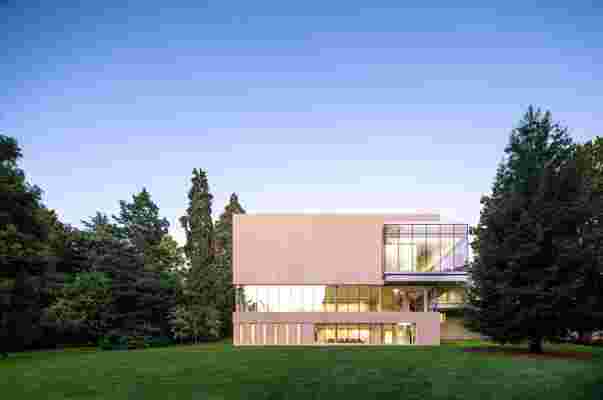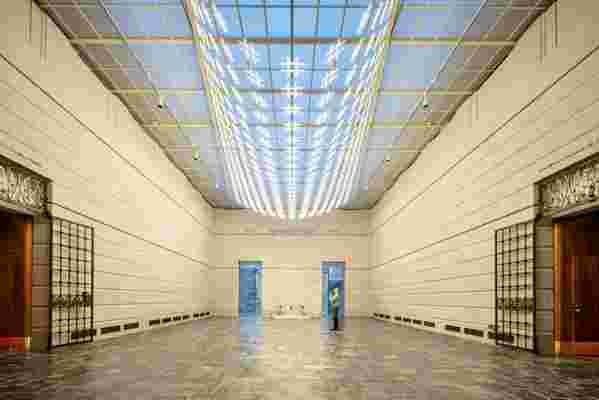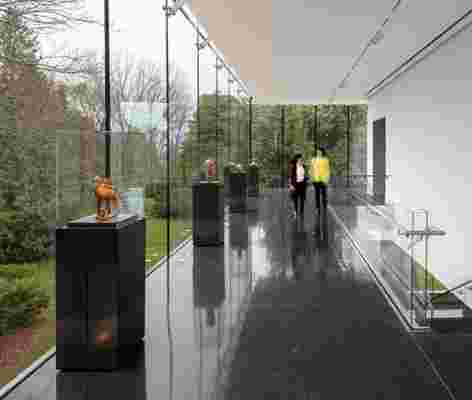Nestled within Seattle's Frederick Law Olmsted–designed Volunteer Park, the 1933 Asian Art Museum, with its distinctive stone facade and decorative aluminum window grilles, looks more like it did on opening day than ever before. After two years closed, the landmarks-designated museum will reopen in the landmarked park on February 8 following an extensive restoration and expansion by LMN Architects. In addition to restoring the facade to its former glory, the Seattle-based firm has updated the museum's decades-old mechanical, electrical, and loading systems; steadied the building in the face of seismic activity; and increased its size in square footage by more than 20%.

The expansion, designed by LMN Architects, on the east side of the Asian Art Museum in Seattle.
Despite the challenges of working with a landmarked property, the architects found a logical integration of the old and new parts of the museum through the original Fuller Garden Court, a central skylight-topped space designed to bring the outdoors in. At the back of the court, two portals open new sight lines to the park beyond, seen through the glass facade of the 13,905-square-foot addition. Galleries, including a new 2,660-square-foot space by LMN that will allow the museum to show traveling and contemporary art exhibitions, are accessed via this core. In this way, the historic building remains the physical and circulatory center of the museum.

The renovated Fuller Garden Court in the Asian Art Museum (facing portals to the expansion).
As one of the city's treasured architectural landmarks, the museum was particularly important to get right, according to the design team. "It’s a gem of a building designed by Carl Gould, arguably one of the most well-known Seattle architects," explains partner Sam Miller. "Our goal for the renovation was to address issues while keeping the historic building as intact as we could. People familiar with the building might see it in a different way because we did a lot of cleaning to enhance the existing architecture." In the Fuller Court, for example, a fountain previously buried under casework will spout water for the first time since the 1960s; in the galleries, the 12-inch-square Masonite floor tiles (originally installed as a cost saver during the museum's Depression-era construction) have been replaced and replicated in larger format in the new exhibition space; and on the exterior, the front windows have been restored with clear glass, giving park passersby a peek into the entry through the grillwork.

The expansion circulation is wrapped in glass.
The extension, then, needed to sensitively bring the museum into the 21st century. "We were looking to create a contemporary expression for the building that is of our time [and] complementary to the historic structure," says partner Wendy Pautz, who notes that the team called upon an arborist to map the site's trees to avoid any disturbance to the park. The result is a precast concrete-and-glass structure concentrated on one side of the back of the Court. It houses the museum's first dedicated education center, an Asian art–specific conservation center, the historic auditorium, offices and meeting rooms, and the new gallery. The new facade's color is distinctive, yet reminiscent of the museum's original stone (which wraps only the front side due to 1930s budget restrictions). And its extensive use of glass, particularly in creating "floating" circulation spaces, displays the abilities of current technology.
A historic octagonal gallery that has been restored now has a light box behind its skylight.
The renovation also means exhibits can be larger in size and scope. "The focus of the museum’s collection previously had been Japanese, Chinese, and Korean art," says Miller, but the addition allows never-seen work from the collection to be on display. A lot of it has to do with space configurations: The additional gallery can be combined with an adjacent one to display large-scale and video work supported by a larger loading dock and dedicated art elevator. And the collections are more protected, with the introduction of light boxes behind the original gallery skylights.
A view of the new gallery featuring contemporary artworks by Ai Weiwei and Do Ho Suh.
When the Asian Art Museum opens on Saturday, the architects hope that previous visitors will see their museum in a new light. Says Amada Cruz, CEO and director of the Seattle Art Museum, “We could not be more excited to open the doors of the museum and welcome everyone back.”
